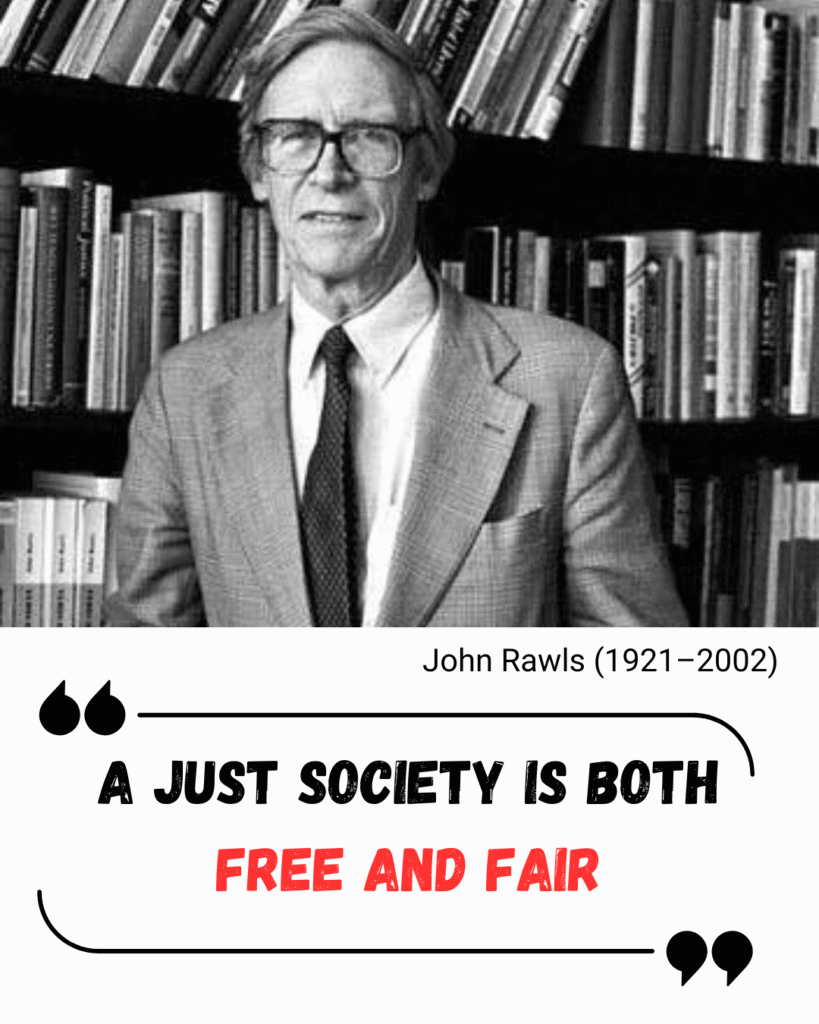John Rawls’s Theory of Justice

John Rawls’s Theory of Justice (1921–2002) stands out as one of the most significant political philosophers of the 20th century.
His groundbreaking work A Theory of Justice (1971) transformed the way we think about fairness, equality, and the moral foundations of a democratic state.
In John Rawls’s Theory of Justice, Rawls introduced the concept of “justice as fairness”, a principle that argues a just society is one where its laws and institutions operate fairly for all citizens—not just for the wealthy or powerful.
Unlike utilitarianism, which focuses on maximizing overall happiness (sometimes at the cost of minority rights), Rawls argued that justice must be the first priority when shaping laws and social structures.
His contributions (Theory of Justice )remain central to contemporary debates on liberty, democracy, equality, and welfare policies, making Rawls a guiding figure in both political theory and real-world policymaking.
Foundational Concepts of John Rawls’s Theory of Justice
To explain how a just society could be imagined, Rawls developed a thought experiment based on two key ideas: the Original Position and the Veil of Ignorance, in his Theory of Justice. These tools allow us to reason about justice in a fair and unbiased way.
The Original Position – A Neutral or Fair Starting Point
Rawls asked us to imagine a scenario where people come together to decide the rules of society—but they do this before they are born. At this stage, no one knows whether they will be rich or poor, privileged or disadvantaged, male or female, strong or weak. This hypothetical situation is what Rawls called the Original Position.
In this setup, everyone is equal and no one knows their social position. Because of this, people are compelled to choose principles that are fair to all, since nobody would risk creating a system that might disadvantage them once they are born into it. This ensures that the foundations of society are agreed upon impartially.
The Veil of Ignorance – Removing Bias
To strengthen this fairness, Rawls introduced the idea of the Veil of Ignorance. Under this veil, individuals are stripped of knowledge about their identity, class, religion, talents, or natural abilities. The only thing they know is that they will be a member of society once it begins.
This “ignorance” prevents favouritism . No one can make laws that benefit their own group because they don’t know which group they will belong to. In this situation of uncertainty, Rawls believed rational individuals would choose principles that protect the most disadvantaged.
Here, the guiding logic is the maximin rule: maximizing the minimum. In other words, people would design a system where even the worst possible position in society guarantees a decent life.
The Two Principles of Justice by John Rawls
From this fair starting point, Rawls argued that people would agree on two fundamental principles of justice. Importantly, these principles are not equal in weight—the principle of liberty comes first and cannot be sacrificed for the sake of social or economic gain.
First Principle – Equal Basic Liberties
The Principle of Greatest Equal Liberty asserts that every citizen should enjoy the same set of basic freedoms, and these freedoms must be as extensive as possible without undermining the freedoms of others.
Some of these include:
• Political liberty: the right to vote and participate in public decision-making.
• Freedom of speech, thought, religion, and assembly.
• Right to own personal property.
• Protection from arbitrary arrest or oppression.
For Rawls, these liberties form the foundation of justice. They cannot be traded away or reduced for the sake of economic growth or social stability. A society must guarantee these freedoms before addressing questions of inequality.
Second Principle – Fair Inequalities
Rawls acknowledged that absolute equality is unrealistic. However, inequalities are only acceptable under two strict conditions:
The Difference Principle
Social and economic inequalities are justified only if they result in benefits for the least advantaged members of society. For example, higher salaries for doctors are acceptable because they create incentives for skilled people to enter the profession—which in turn benefits everyone, including the poor, through better healthcare.
Together, these principles balance liberty, equality, opportunity, and fairness
Fair Equality of Opportunity
Opportunities in society must be genuinely open to all, not just legally but also practically. This means removing barriers such as poor education, systemic discrimination, or inherited privilege. True fairness requires that a child from a disadvantaged background has the same chance at success as one from a wealthy family.
Together, these principles form a balance: freedom for all, with fairness in opportunities and protections for the disadvantaged.
Rawls’s Vision of a Just Society – Freedom with Fairness
For Rawls, a just society is both free and fair. It is democratic, respects individual rights, but also ensures that no one is left behind.
A society guided by John Rawls’s Theory of Justice would:
• Guarantees equal rights to all citizens.
• Structures its economy to work for everyone, not just the elite.
• Provides welfare systems, healthcare, and education to uplift the disadvantaged.
This does not mean forced economic equality. Instead, it creates a society where wealth and opportunity are distributed in ways that ensure dignity and decent living conditions for all.
Modern Thinkers Compared with John Rawls’s Theory of Justice
To understand Rawls better, it’s useful to compare him with other modern thinkers.
| Philosopher | Core Theory | Key Concepts | Focus of Justice | State’s Role |
| John Rawls | Justice as Fairness | Original Position, Veil of Ignorance, Two Principles | Fair distribution of primary goods | Justifies welfare state policies |
| Robert Nozick | Entitlement Theory | Acquisition, Transfer, Rectification, Minimal State | Justice in property rights | Minimal state, opposes redistribution |
| Amartya Sen | Capability Approach |
Capabilities, Functioning, Real Freedoms | Real opportunities for well-being |
State expands opportunities, addresses inequality. |
Criticisms of John Rawls’s Theory of Justice
Like any influential idea, Rawls’s theory attracted strong critiques from fellow philosophers.
Robert Nozick’s Entitlement Theory – Libertarian Critique
Robert Nozick challenged Rawls with his Entitlement Theory, presented in Anarchy, State and Utopia. Drawing from Locke, Nozick defended the “night-watchman state”—a minimal government limited to protecting life, liberty, and property.
Nozick argued that:
• Individuals are entitled to keep what they earn or fairly acquire.
• Heavy taxation for redistribution is equivalent to forced labour.
• Redistribution is only justified when property has been unjustly acquired.
• A government that constantly adjusts wealth to benefit the least advantaged undermines freedom.
His Entitlement Theory rests on three principles:
- Just Acquisition – Resources acquired through one’s own effort belong to the individual.
- Just Transfer – Property can be voluntarily exchanged or gifted, and this transfer is just.
- Rectification – Any unjust acquisition in the past must be corrected.
In short, Nozick believed Rawls gave the state too much power, while true justice lies in protecting individual rights, not redistributing wealth.
Amartya Sen’s Capability Approach – Moving Beyond Primary Goods
Amartya Sen, in The Idea of Justice, critiqued Rawls’s focus on “primary goods” (such as income, rights, and opportunities) as the measure of justice.
Sen argued that:
• Equal distribution of goods doesn’t guarantee equal well-being, since people differ in their ability to use resources.
• Justice should instead be assessed by capabilities—what individuals can actually do and become.
• For instance, a person with a disability may need more resources than others to achieve the same level of mobility.
• Unlike Rawls’s transcendental approach (seeking a perfect society), Sen promoted a comparative approach—improving justice step by step, even if society never reaches perfection.
Quotes on Justice
• “To each according to his capacity, to each according to his need.” – Saint Simon
• “Justice is the reconciler and the synthesis of political values; it is their union in an adjusted and integrated whole.” – Barker
• “Justice consists of a system of understanding and procedures through which each is accorded what is agreed upon as fair.” – Charles Merriam
Further Readings on Justice:
• Political Theory and International Relations – Charles Beitz
• Humanity and Justice in Global Perspective – Brian Barry
• The Liberal Theory of Justice – Brian Barry
• Justice – Tom Campbell
• Justice: What’s the Right Thing to Do? – Michael Sandel
Conclusion – Why John Rawls’s Theory of Justice Still Matters
Rawls’s theory of “justice as fairness” is more than philosophy—it is a guide to building societies that value human dignity. His framework gives us two clear steps:
Equal Basic Liberties – Secure fundamental rights and freedoms for every citizen.
Difference Principle + Fair Opportunity – Allow inequalities only if they help the least advantaged, and ensure real opportunities for all.
Though critics like Nozick and Sen offer important challenges, Rawls’s ideas continue to shape how we think about fairness in democracy, welfare, education, and economic systems.
His famous question still echoes today:
“If you didn’t know who you’d be in society, what rules would you choose?”
For Rawls, the answer was simple yet powerful: protect liberty, ensure fairness, and uplift those who are worst off. This remains a timeless framework for anyone seeking a just and humane society.

Pingback: What is liberty in political science - reeneworld.com
Thankyou, this blog was very helpful
Pingback: Plato Theory of Justice - reeneworld.com